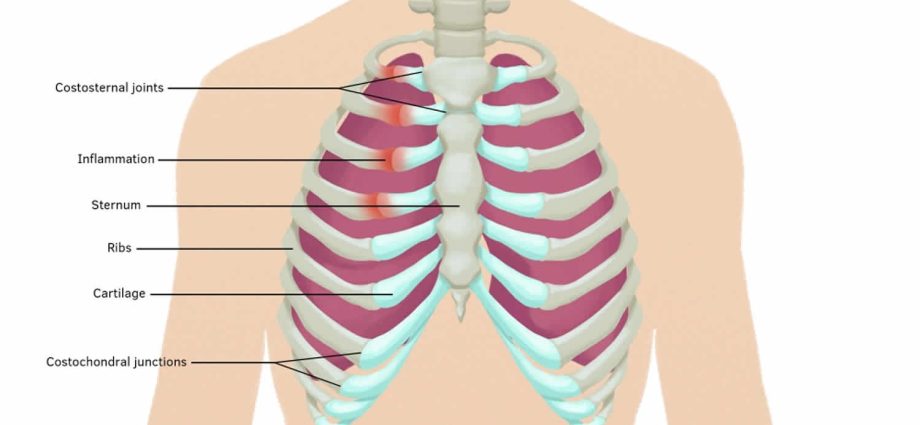Contents
Severe pain in the chest that radiates to the arms and shoulder – for most people the first thought that this symptom evokes is a heart attack. It turns out, however, that it is a non-specific symptom, that is, one that may indicate the presence of more than one disease. One of them is Tietz syndrome, or costal cartilage inflammation.
What is Tietz syndrome and what causes it?
The essence of Tietz syndrome is the formation of inflammation of the rib-sternal joints, that is, the places where the ribs meet the sternum. Most often, the disease develops within one joint.
The exact causes of Tietz syndrome are unknown. However, it is suspected that the following factors contribute to the formation of costal cartilage inflammation:
- injuries to the chest area, e.g. as a result of a strong impact against the steering wheel in a car accident,
- overload resulting from too strenuous exercise or hard physical work, especially when lifting very heavy objects,
- viral infections in the respiratory system,
- neoplasms of the sternocostal joint,
- other inflammatory diseases of the joints which may increase your risk of Tietz syndrome.
These diseases mentioned above include:
- Reiter’s syndrome, or so-called reactive arthritis. These are inflammatory conditions of the joints that occur after inflammation of the intestines or urethra.
- Rheumatoid arthritis. It is a chronic rheumatic disease. Tietz’s syndrome may occur during the worsening phase of this condition.
- Ankylosing spondylitis, i.e. inflammation of the spinal tissues leading to stiffness. It can spread to other parts of the skeleton, causing Tietz’s syndrome.
Diagnostics of the Tietz syndrome
The main symptom of Tietz syndrome is chest pain, which worsens especially with any movement. It is worth paying attention to symptoms such as pain when twisting the torso or bending down, standing up and sitting down, as well as in situations where the lungs are pressed against the sternum, i.e. when coughing, sneezing and inhaling deeply.
As we said, these are non-specific symptoms. They may indicate a heart attack, but also intercostal neuralgia, i.e. neuralgia in the area of the ribs. Therefore, in the event of such ailments, you should immediately consult a doctor in order to obtain a correct diagnosis. Various imaging methods such as X-ray or ultrasound can help.
Treatment of Tietz syndrome
Tietz’s syndrome, although painful and bothersome, is fortunately not difficult to treat. First, anti-inflammatory and analgesic agents are introduced to facilitate normal functioning of the patient. In many cases, over-the-counter drugs such as paracetamol, ibuprofen or ketoprofen are sufficient. If Tietz’s syndrome is more severe, topical anti-inflammatory ointments and gels, as well as stronger prescription painkillers, including opioids such as tramadol and oxycodone, may be added to treatment. In such cases, sedative medications are also sometimes recommended, because severe pain, especially in the chest area, and thus also in the heart, may cause significant anxiety and psychological discomfort in the patient.
A necessary element of the treatment of Tietz syndrome is also enabling the proper regeneration of inflamed tissues. In the first place, it is rest and refraining from excessive physical exertion. Overloading can be prevented by the use of a special tourniquet. In addition, the alternating use of warm and cold compresses has a positive effect on the joints.
Thanks to the above methods, the disease usually disappears completely. However, if this is not the case, the doctor may order additional rehabilitation for a patient with Tietz syndrome. Most often it takes the form of working with a physiotherapist. There is also a new method of treating Tietz’s syndrome with a laser. The painless and non-invasive laser beam stimulates cells to regenerate, facilitating treatment.










